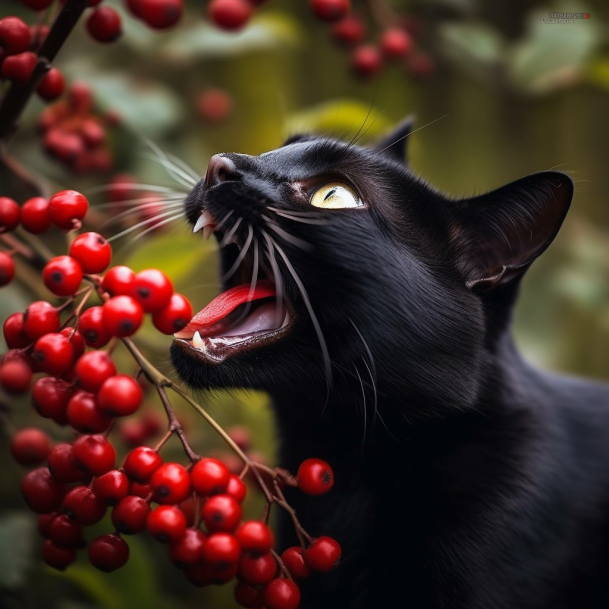Are Hypericum Berries Poisonous to Cats? Meow and Find Out!

"Today, let's talk about something super important: hypericum berries and whether they're bad for us feline friends." - Miles the Maine Coon
Introduction
Hey there, fellow feline enthusiasts! Have you ever wondered if hypericum berries, also known as St. John's wort berries, are safe for us cats to munch on? Well, buckle up because today we're delving into the intriguing world of hypericum berries and uncovering whether they pose any risks to our curious taste buds. As responsible hoomans, it's vital to understand the characteristics, composition, and potential dangers associated with these berries to ensure our well-being and keep us purring with joy.
As a sophisticated feline, it's crucial for our hoomans to be aware of foods that can be harmful or toxic to us. By identifying toxic foods, they can create a safe and loving environment where we can thrive without accidentally nibbling on anything dangerous. When it comes to hypericum berries, it's all about understanding the potential risks involved so that our hoomans can take necessary precautions and keep us happy, healthy, and full of energy. So, let's jump right into the world of hypericum berries and discover if they're a yay or a nay for us cats!
Hypericum Berries and Cats
Meow! Let me tell you a bit about hypericum berries. These tiny fruits come from the Hypericum plant family and can be found in various species. They often come in eye-catching red or black colors and are quite popular in herbal medicine for hoomans due to their potential health benefits. However, the big question remains: are hypericum berries safe for us fabulous felines? Let's find out together!
There are a few common varieties of hypericum berries that our hoomans should be aware of. The most well-known is Hypericum perforatum, aka St. John's wort, which sports yellow flowers and black berries. Another variety is Hypericum androsaemum, also known as tutsan or sweet amber, which boasts vibrant red berries. The toxicity level of these berries may vary depending on the specific species, so it's important for our hoomans to know exactly which type is present to evaluate any potential risks.
When it comes to the potential toxicity of hypericum berries for us cats, several factors come into play. The concentration of toxic compounds in the berries, the amount we gobble up, and our individual sensitivity can all affect how dangerous these berries are for us. Plus, the ripeness of the berries and the specific species of hypericum can also impact their toxicity. It's a lot to consider, but our hoomans are always looking out for us.
We cats have an inquisitive nature, and exploring our surroundings is one of our favorite pastimes. It's possible for us to come across hypericum berries if they're around us. Whether we're sniffing out gardens, venturing into outdoor spaces, or even investigating indoor houseplants, there's a chance we might stumble upon these berries. To keep us safe, it's crucial for our hoomans to be mindful of hypericum plants and take measures to prevent our little paws from reaching them.
Are Hypericum Berries Poisonous to Cats?
Let's cut to the chase. Are hypericum berries poisonous to us fabulous felines? Well, in small quantities, they might not be too concerning, but if we munch on a bunch or keep coming back for more, it can lead to some serious trouble. Our sensitive tummies don't always agree with the compounds found in hypericum berries, which can cause some unpleasant effects on our health. So, it's crucial for our hoomans to know the risks and take the necessary steps to keep us safe and sound.
Those hypericum berries contain various compounds that can be toxic to us cats. One of the main troublemakers is hypericin, which can wreak havoc on our nervous systems. There's also hyperforin and a few other compounds that contribute to the potential toxicity of these berries. Understanding the presence of these toxic compounds is essential for evaluating the risks associated with us giving them a taste test.
If we ever chomp on hypericum berries, we may experience a range of symptoms associated with poisoning. These can include tummy troubles like vomiting and diarrhea, as well as neurological symptoms such as restlessness, agitation, and sensitivity to light. We might also show signs of depression, lose our appetite, or have an increased heart rate. Our hoomans should keep a close eye on us and seek veterinary attention promptly if they suspect we've been feasting on those pesky berries.
Gobbling up hypericum berries can lead to some serious health complications for us cats. Those toxic compounds can wreak havoc on our central nervous system, potentially causing seizures, tremors, and disorientation. Additionally, the stomach woes caused by these berries can lead to dehydration and nutrient imbalances if left untreated. That's why it's crucial for our hoomans to whisk us away to the vet pronto if they suspect we've been on a berry binge.
Prevention and Safety Measures
As savvy feline detectives, it's important for our hoomans to be able to identify hypericum berries and keep us safe from their clutches. They should familiarize themselves with the appearance of hypericum plants, including the leaves, flowers, and berries. It's crucial to tell those toxic berries apart from the safe ones to prevent any accidental munching. Hoomans can consult with gardening experts or reliable sources to get the lowdown on these sneaky berries.
To protect us from potential hypericum berry mishaps, our hoomans need to create a safe environment where those berries are out of our paw's reach. This means removing hypericum plants from areas we can access, like gardens or indoor spaces. If it's not possible to get rid of them completely, our clever hoomans can use physical barriers or deterrents to keep us away from those tempting berries.
Since we cats love to explore plants and berries, our hoomans can provide safe alternatives to redirect our attention and keep us entertained. Offering cat-friendly plants or toys designed to stimulate our natural hunting instincts can satisfy our curiosity without putting us in harm's way. It's all about keeping us happy, engaged, and far away from those potentially harmful hypericum berries.
It's essential for our hoomans to spread the word about the dangers of hypericum berries to us fabulous felines. They can share this valuable information with other cat owners, friends, and family members to raise awareness. The more people know about the risks, the safer the environment becomes for all us feline companions. So, let's educate others and make sure our fellow felines stay purrfectly safe.
What to Do If Your Cat Eats Hypericum Berries
If our hoomans catch us red-pawed munching on hypericum berries, it's crucial for them to act swiftly. They should remove any remaining berries from our vicinity to prevent further munching. Then, they should keep a close eye on us and watch for any immediate symptoms that may arise.
Next up, our hoomans should reach out to a veterinarian if they suspect we've had a berry feast. They should inform the vet about the situation, including how many berries we gobbled up, the time it happened, and any symptoms we're showing. The veterinarian will provide guidance on the next steps based on our specific situation.
Once we're whisked off to the vet, they'll assess our condition and determine the appropriate treatment. Taking care of hypericum berry poisoning might involve inducing vomiting, giving us activated charcoal to absorb any remaining toxins, and providing supportive care to manage symptoms and prevent complications. The vet will tailor the treatment plan to meet our individual needs and get us back on our paws in no time.
Other Foods to Be Cautious About
Hypericum berries aren't the only troublemakers when it comes to toxic foods for us cats. There are other common foods that can be harmful to us, like chocolate, caffeine, onions, garlic, grapes, raisins, alcohol, and certain artificial sweeteners like xylitol. Our hoomans need to familiarize themselves with these sneaky foods to make sure they're not accidentally offering us something that could make us sick.
Keeping us nourished and safe is crucial for our overall health and well-being. That's why our hoomans should provide us with a balanced and safe diet designed specifically for feline tummies. Sharing human food should be a big no-no unless our hoomans are absolutely sure it's safe for us. Consulting with a veterinarian can help our hoomans determine the best diet and feeding practices for our specific needs.
Conclusion
In conclusion, hypericum berries can be a real danger to us fabulous felines. We need our hoomans to be aware of the risks and take preventive measures to keep us safe. By knowing how to spot hypericum berries, keeping them away from our curious paws, providing safe alternatives, and educating others about the dangers, our hoomans can create a purrfectly safe environment for us. And if we ever do get our paws on those tricky berries, our hoomans should act swiftly and seek veterinary care right away. Together, we can keep all us feline friends happy, healthy, and far away from those naughty hypericum berries.

